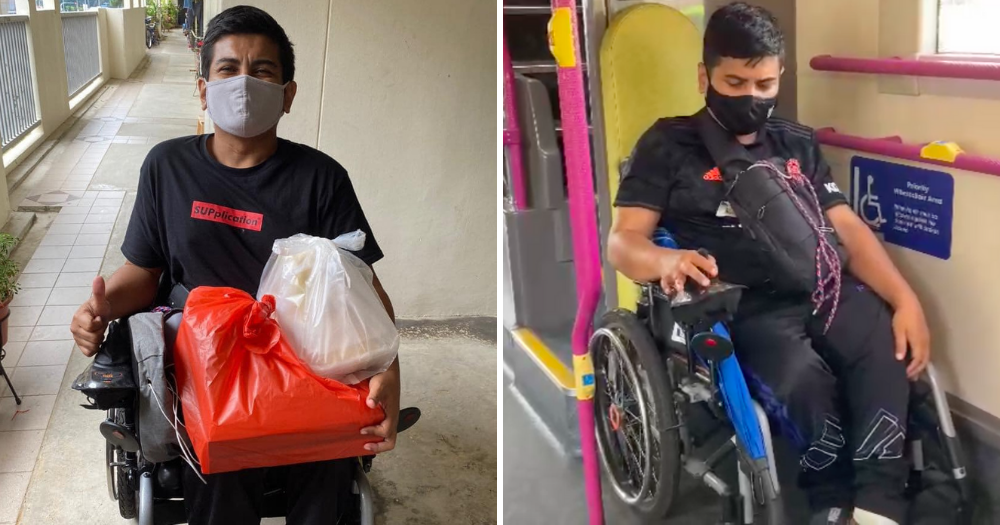It's a Friday afternoon and I'm sitting across from 39-year-old Mohamed Zahid Bin Mohd Yassin in a Starbucks at Waterway Point as he tells me about the courier service that he runs.
It is rather unique, compared to most other couriers in Singapore.
While other couriers usually utilise motorbikes or trucks to pick up and deliver items around the island, Zahid's mode of couriering exclusively uses the MRT and buses. Oh, and his wheelchair.
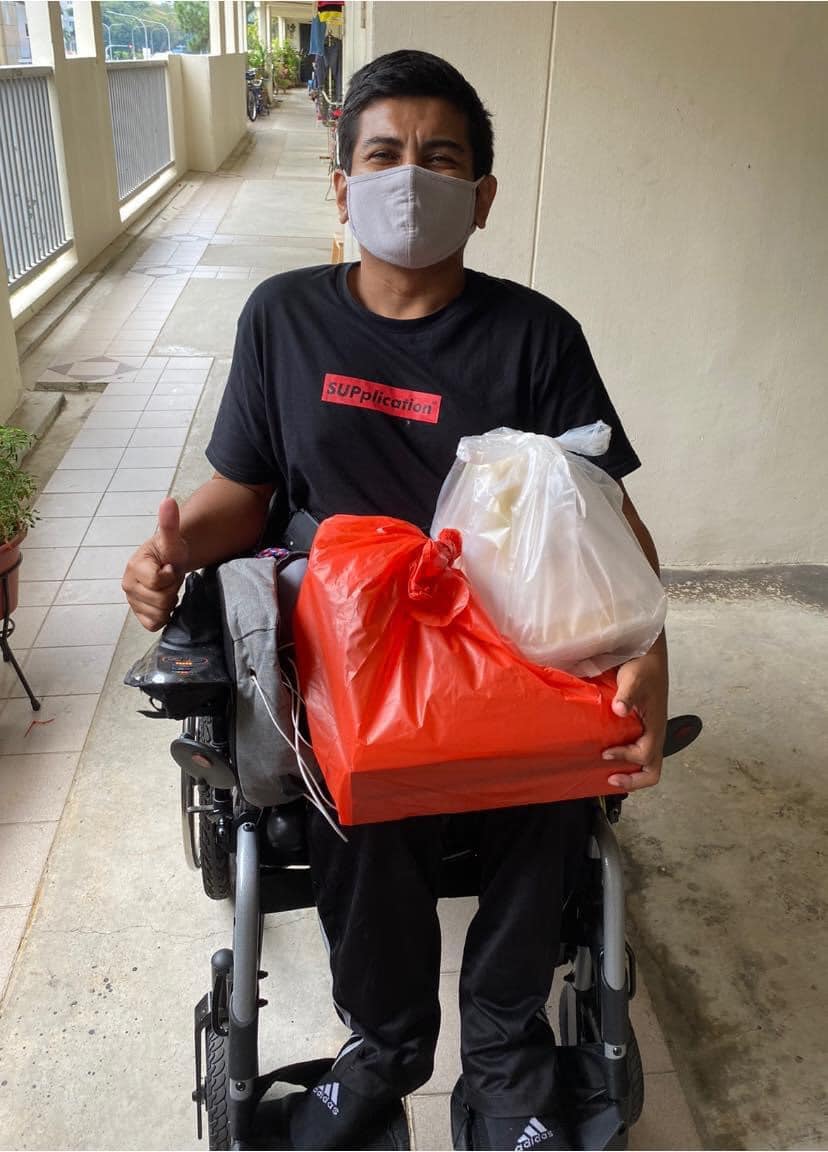 Photo via Facebook / Zarina Jaffar.
Photo via Facebook / Zarina Jaffar.
Zahid, who is a wheelchair user, was born with spina bifida, a condition that occurs along the spine when the neural tube doesn’t form and close, which often results in damage to the spinal cord and nerves.
Growing up, he was unable to feel sensation in his legs, but he was still able to walk with the aid of crutches and leg braces.
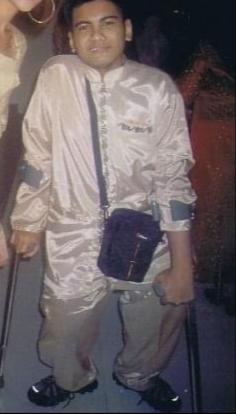 Photo courtesy of Zahid.
Photo courtesy of Zahid.
However, when Zahid was 17 years old, his condition began to deteriorate, and he no longer was able to walk using crutches, and began using a wheelchair at his doctor's suggestion.
Started own courier business
After graduating from ITE College Central, Zahid worked full-time as an admin assistant cum telemarketer and customer service representative.
Four years ago, he was falling ill and being hospitalised often due to health issues, which hindered his ability to continue with his full-time work.
Eager to still find an alternative way to support himself, Zahid looked around and took inspiration from people who he saw doing deliveries.
He decided to start his own business — Ayeed the Courier — delivering small items and packages across the island using only his wheelchair and public transportation.
Affordable rates for hand-carried goods
Because Zahid does his deliveries using his wheelchair and public transportation, he only delivers items that are not too bulky and can be hand-carried, such as packed food, clothing, and small to medium parcels.
 Zahid stores the items that he is couriering in a bag attached to the back of his wheelchair. Photo courtesy of Zahid.
Zahid stores the items that he is couriering in a bag attached to the back of his wheelchair. Photo courtesy of Zahid.
He offers both same-day and three-day delivery. For delivery within three days, Zahid charges a flat rate of only S$5 per trip.
For same-day delivery, he charges, based on distance; for deliveries of less than 8km, S$6. Between 8km and 10km, it costs S$8. And for deliveries that span more than 18km, Zahid charges S$10.
He explains that he decided on his prices after calculating his own costs and seeing what the home-based businesses that he works with needed:
"I saw that some of them were really concerned about the high costs charged by [other] delivery services."
Plus, he says, he is able to charge less because compared to other courier services that need to pay upkeep and fuel prices for their vehicles, his cost is pretty minimal:
"For me, I only depend on buses and trains. So it's less cost for me."
But, I ask Zahid, isn't spending hours every day going back and forth across the island tiring for him?
He responds frankly,
"To be honest, it is tiring. But to me, having an income, [even though] it's not that big, I really feel relief, that I can do something.
That I can earn my own income, on my own time and at my own pace."
Public transportation has given him independence
The public transportation situation has improved greatly since his childhood, Zahid says.
Back when he was younger, in order to go anywhere, he was usually dependent on taxis as a main mode of transport.
"That's why before accessibility for wheelchairs was implemented on buses and MRTs, my social life was not really active.
Mostly I would be staying at home, because I couldn't afford to go anywhere."
He thinks back to those days, laughing as he remembers:
"During my early years, I hardly go Jurong. That time I stayed Hougang. So I only go Jurong during Hari Raya, so once a year."
Only after the North-East Line opened in 2002 did public transport give him the independence to go out on his own, and Zahid says that he is content with the current public transportation system.
"Now, this delivery service makes me go Jurong every day, because my clients are mostly there.
I can go to any places that I want — even the south, like Marina Bay, I also do deliveries there."
Still faces some struggles
While the experience of taking public transportation has been greatly empowering for Zahid, he has faced a fair share of challenges throughout his journey:
"There's always barriers for us people with disabilities, especially those who are on wheelchairs.”
For example, many of us are guilty of getting out of the MRT train and seeing the lift right there, way closer than the escalators, and opting to take the lift instead.
So how often does Zahid have to deal with being unable to use the lift because it is crowded with non-wheelchair users?
"Daily," he tells me, with the resigned amusement of someone who has found himself in that situation far too many times.
At times, he says, people completely ignore his presence.
"Sometimes, I say, 'Excuse me, I need the lift. Can you please make way for me?' They don't even bother, they just go up."
He has been heartened by some kind — and youthful — commuters, though:
"Kids are the ones who ask their parents to take the stairs [and escalators].
They go inside [the lift] already, then they ask, “Mummy, let’s take the stairs. Let’s let this uncle go in."
Taking the bus
Another struggle for Zahid is crowded buses.
Wheelchair users must park their wheelchairs in the wheelchair bay, facing backwards against the padded backrest and with their brakes on for safety reasons, as this minimises the risk of the wheelchair tipping over when the bus is moving.
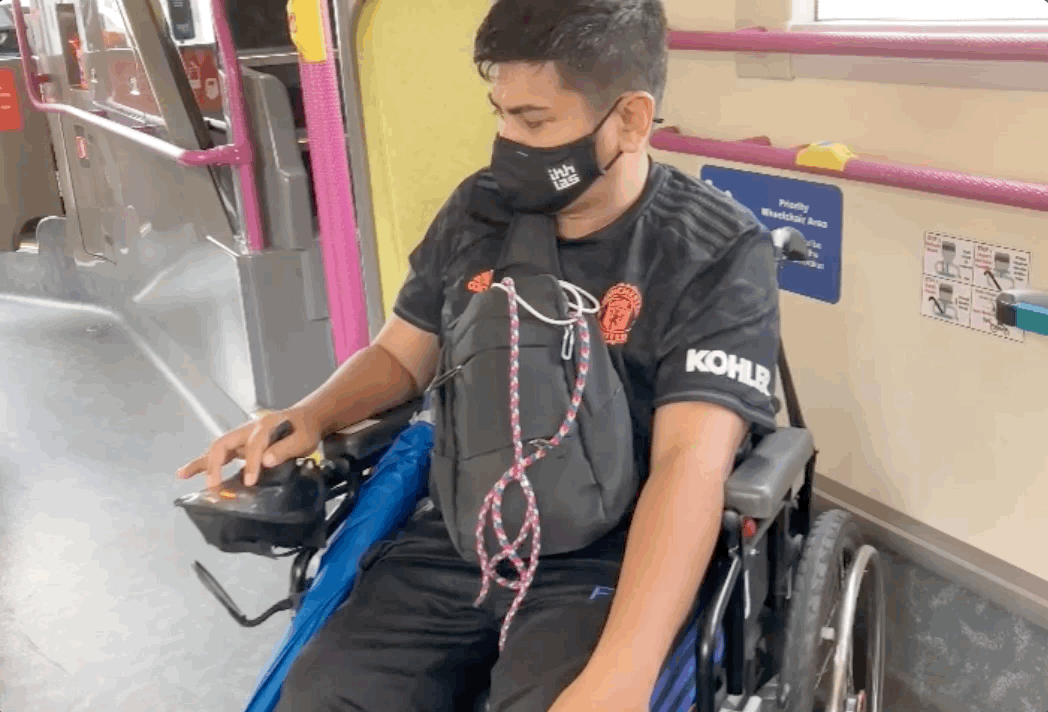 Gif by Jane Zhang.
Gif by Jane Zhang.
Many of the older buses have only one wheelchair bay, so when the spot is occupied by another wheelchair user, Zahid has no choice but to wait for the next bus.
The newer buses rolled out by Land Transport Authority (LTA) since 2018, though, have two wheelchair bays, which allow for two wheelchair users to be safely parked onboard at any given time.
Even when there is a wheelchair bay is free, though, sometimes passengers who are standing don't move out of the way for Zahid.
"Some of them, I'm already in front of them, but they still can stand there like I'm not visible.”
One way to avoid these kinds of situations is for passengers who are standing in a crowded double-decker bus to move to the upper deck instead, if they are physically able to.
This then makes room for commuters who need to be on the lower deck, such as wheelchair users like Zahid and seniors.
Fostering a caring commuter culture
To support commuters who may have conditions that are not as outwardly visible as Zahid's, LTA introduced the "May I have a seat" initiative in 2019.
Commuters with less visible health conditions or disabilities who need a seat on public transportation can collect the "May I Have a Seat Please" lanyard and card from the passenger service centres located within MRT stations, bus interchanges, and integrated transport hubs.
 Photo courtesy of LTA.
Photo courtesy of LTA.
The lanyard and card can then be displayed to alert fellow commuters that they require a seat, and commuters are encouraged to offer their seat to people wearing it.
Commuters are also encouraged to give seats to those who need them more — for example, senior citizens, expectant mothers, and parents with young children.
All of these measures to support commuters such as wheelchair users, seniors, and individuals with invisible conditions are part of LTA’s initiative to foster a caring commuting culture, which requires everyone to work together and play their part as part of the community effort.
Accessibility features for wheelchair users
Over the years, LTA has introduced a variety of features to improve accessibility for wheelchair users like Zahid.
The access ramp, which is deployed by the bus captain, enables wheelchair users to board the bus smoothly from the pavement.
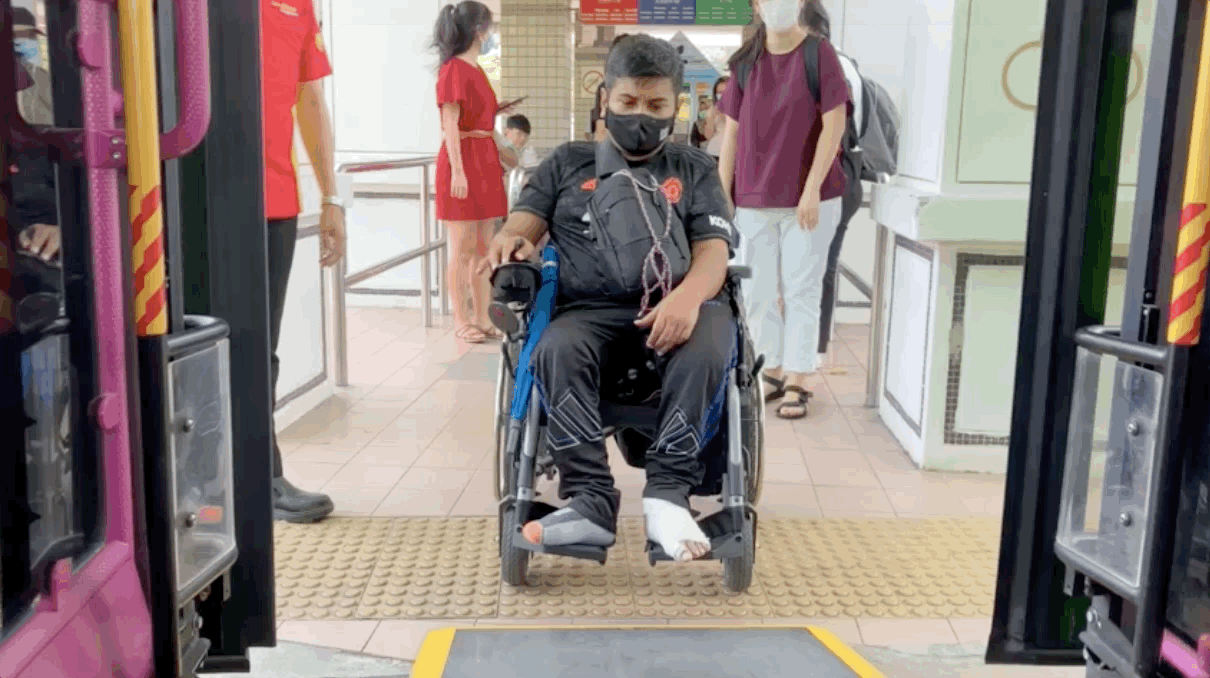 Gif by Jane Zhang.
Gif by Jane Zhang.
There are also specially-placed bell push buttons for wheelchair users, which are placed at a lower height for easier reach — either on the horizontal handrail or on the vertical pole.
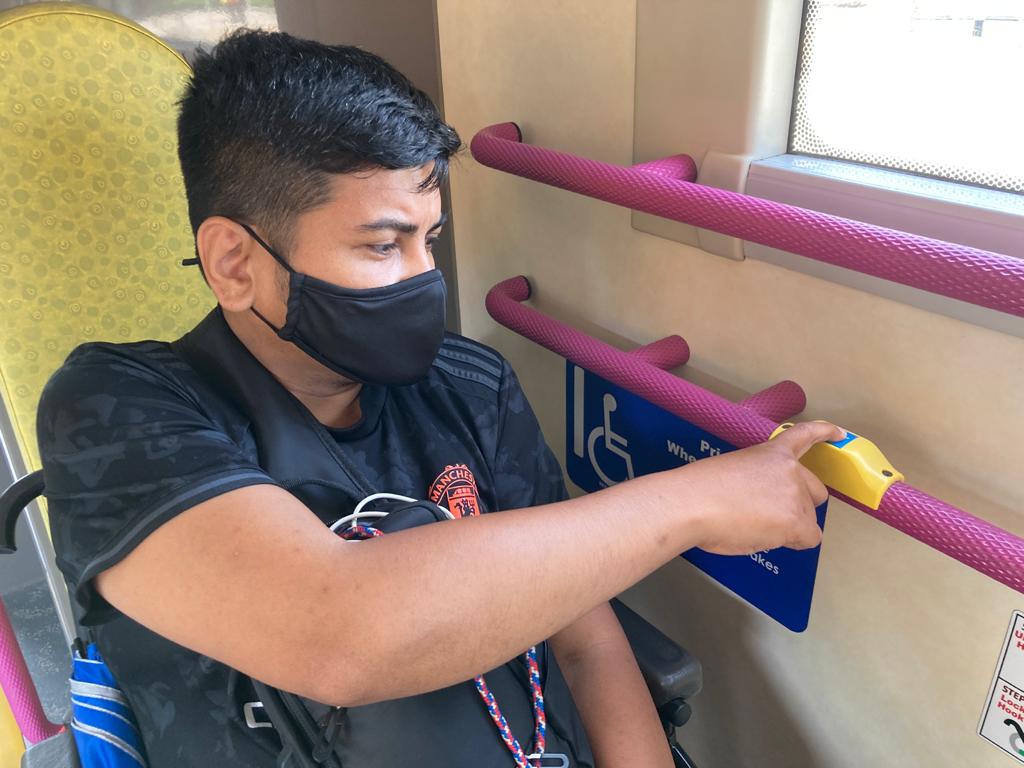 Photo by Jane Zhang.
Photo by Jane Zhang.
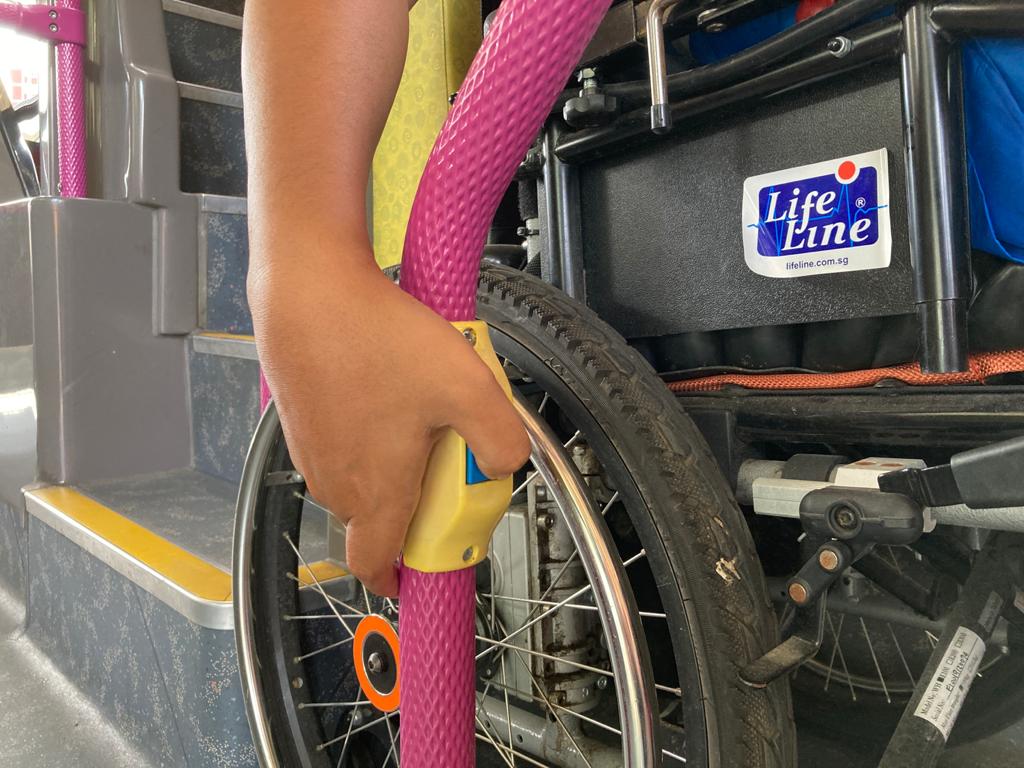 Photo by Jane Zhang.
Photo by Jane Zhang.
The bells are also programmed with a different sound than the other stop bells, to indicate to the driver that a wheelchair user is getting off at the next stop.
Wheelchair users and other commuters can also help signal to the bus captain that a wheelchair user needs the ramp to be deployed by pressing the wheelchair push button at the side of the bus' second door.
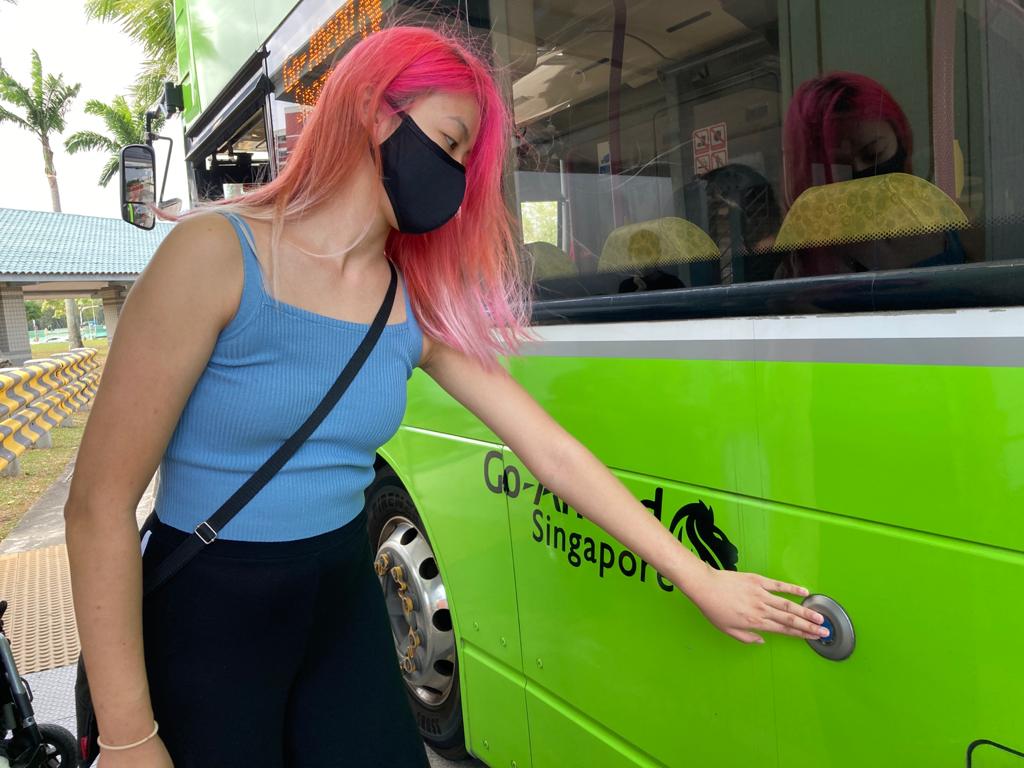 Commuters can play their part and help signal to bus drivers by pressing the button. Photo by Aisyah Iskandar.
Commuters can play their part and help signal to bus drivers by pressing the button. Photo by Aisyah Iskandar.
Be grateful for your mobility
"Is there anything you wish that people would know about your experience of being in a wheelchair?", I ask Zahid.
"I would tell them that they should be grateful that they still can walk and they are still able to go up the stairs," he responds, without hesitation.
He shares:
"I, myself, [in these] 39 years, I would want to go up the stairs. If I got the [ability] to walk, I would surely use the stairs more often."
"I managed to... but by using the ramp," he jokes good-naturedly.
Zahid also asks that people learn to better understand wheelchair users and people with disabilities like him, and to not look at them with pity.
"I don't want people to pity me. I'd feel better if people get inspired by me."
This sponsored article is brought to you by the Caring SG Commuters Committee.
Stories of Us is a series about ordinary people in Singapore and the unique ways they’re living their lives. Be it breaking away from conventions, pursuing an atypical passion, or the struggles they are facing, these stories remind us both of our individual uniqueness and our collective humanity.
Top photos via Facebook / Zarina Jaffar and courtesy of Zahid. Some quotes have been edited for clarity.
If you like what you read, follow us on Facebook, Instagram, Twitter and Telegram to get the latest updates.
